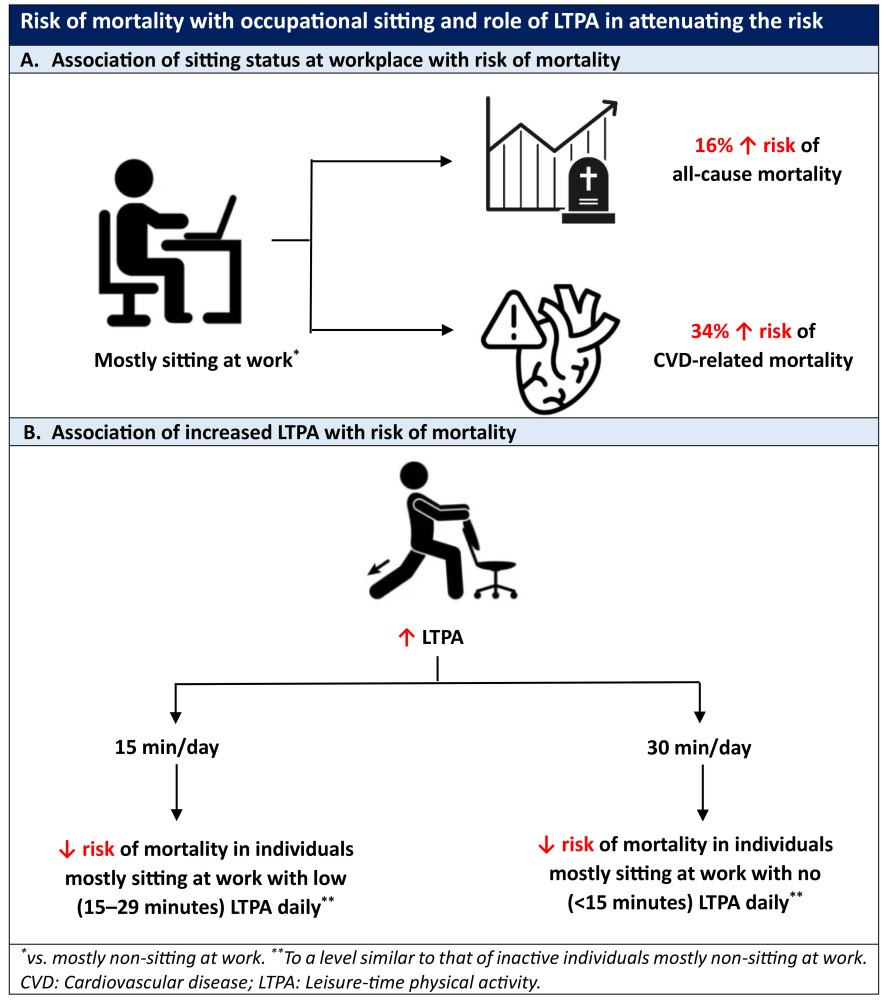
Sedentary lifestyle has become increasingly prevalent in modern times, with prolonged sitting at workplace being considered a key part of normal life. At many workplaces, individuals are noted to sit for prolonged periods, despite being aware of the adverse health effects associated with sedentary behavior. The World Health Organization has issued physical activity guidelines in 2020, which recommend reducing sedentary behavior in view of their adverse health consequences. The specific association of prolonged occupational sitting with health, particularly low physical activity engagement, has not been adequately evaluated.
A recent study by Gao W et al., published in the journal “JAMA Network Open”, reported that prolonged sitting at work is associated with increased mortality risk – 16% higher risk of all-cause mortality and 34% higher risk of cardiovascular disease (CVD) mortality. The study also reported that the estimated risk can be reduced by taking regular breaks at work and performing 15–30 minutes of leisure-time physical activity (LTPA) daily.
This large prospective cohort study included 4,81,688 participants (mean [SD] age: 39.3 [12.8] years; 53.2% women), who were followed up over a mean period of 12.85 years. The participants completed a questionnaire on their medical history and lifestyle risk factors and provided biological samples for testing during each follow-up visit. Occupational sitting status was categorized as mostly sitting, alternating sitting and non-sitting, and mostly non-sitting. Based on the reports of weekly LTPA intensity and duration of LTPA in the last month, study participants were categorized into five LTPA groups: inactive, low, medium, high, and very high. Physical activity levels were determined using the personal activity intelligence (PAI) metric, a physical activity tracker that can incorporate personalized heart rates in response to activity. Data on all-cause and CVD-related mortality was obtained from the National Death Registry. Multivariable Cox regression models were used to calculate the hazard ratios (HRs) for all participants and by subgroups.
- Majority of the participants were in the mostly sitting group (60.2%), followed by alternating sitting and non-sitting group (29.1%), and non-sitting group (10.7%).
o 47.5% of the mostly sitting group, 51.7% of the alternating sitting and non-sitting group, and 57.2% of the mostly non-sitting group were physically inactive.
- A total of 26,257 deaths were noted during the study follow-up period, with more than half (57%) of the deaths occurring in individuals mostly sitting at work. There were 5,371 CVD-related deaths, with 60% occurring in the mostly sitting group.
- Individuals who mostly sat at work showed a higher risk of death from all causes (16%; HR 1.16; 95% confidence interval [CI] 1.11–1.20) and CVD (34%; HR 1.34; 95% CI 1.22–1.46) compared to those who usually did not sit, after adjusting for gender, age, education, smoking, drinking, and body mass index (Graphic A).
- Compared with mostly non-sitting individuals at work, individuals in the alternating sitting and non-sitting group were not at an increased risk for all-cause mortality (HR 1.01; 95% CI 0.97–1.05).
- Considering individuals with LTPA levels ranging from inactive to high, a significantly higher risk of all-cause mortality was noted in individuals of the mostly sitting group compared to those in the mostly non-sitting and alternating sitting and non-sitting groups.
- Among individuals mostly sitting at work with low (15–29 minutes) or no (<15 minutes) LTPA daily, increasing LTPA by 15 and 30 minutes per day, respectively, reduced the risk for mortality to a level similar to that of inactive individuals mostly non-sitting at work (Graphic B).
- Additionally, there was a significant reduction in the increased risk of mortality associated with prolonged occupational sitting for individuals with a PAI score more than 100.

Clinical implications
- The study findings highlight that the detrimental effects of prolonged sitting at work are more prominent in individuals engaged in “no or low level of physical activity”.
- The findings of this study, which included a large prospective cohort, help to strengthen the increasingly accumulating evidence linking a sedentary lifestyle and health risks.
- Emphasizing the associated harms of prolonged sitting and suggesting workplace systemic changes such as more frequent breaks, standing desks, designated workplace areas for physical activity, and gym membership benefits can help denormalize this common behavior and lower the associated health risks.
(Source: Gao W, Sanna M, Chen YH, Tsai MK, Wen CP. Occupational sitting time, leisure physical activity, and all-cause and cardiovascular disease mortality. JAMA Netw Open. 2024 Jan;7(1):e2350680. Doi: 10.1001/jamanetworkopen.2023.50680)
